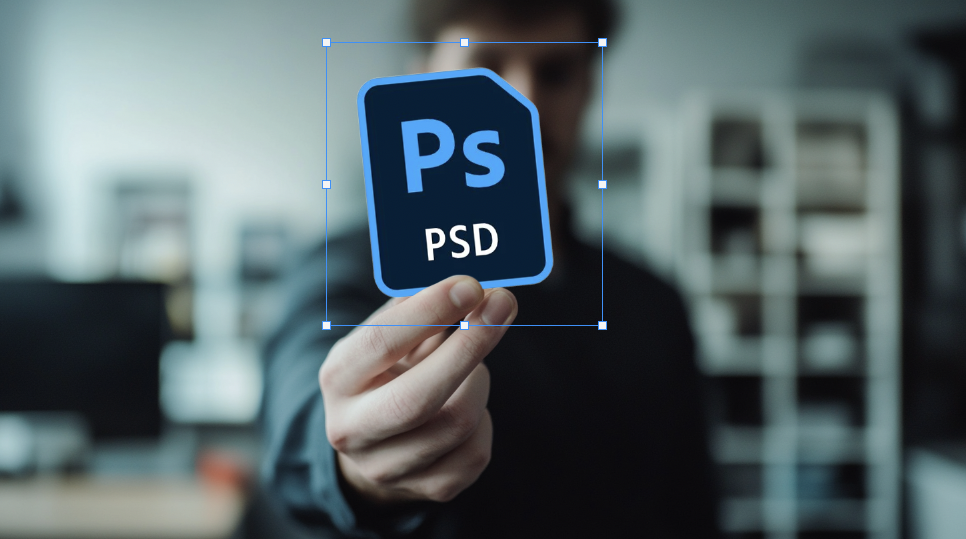In this article:
- What Is a PSD File?
- The History and Evolution of PSD Files
- What Are PSD Files Used For?
- The Advantages of Working with PSD Files
- The Limitations of PSD Files
- How to Open and Edit PSD Files
- Converting PSD Files to Other Formats
- Best Practices for Working with PSD Files
- PSD Files in Client Work
- Troubleshooting Common PSD Issues
- The Future of PSD Files
- Conclusion
If you’ve spent any time in the design world, you’ve likely encountered PSD files. But what exactly are they, and why do they matter so much to designers?
Let’s dive into everything you need to know about PSD files – from their basic definition to advanced uses that can elevate your design work.
What Is a PSD File?
PSD stands for “Photoshop Document,” and it’s Adobe Photoshop’s native file format. Unlike standard image formats like JPG or PNG, a PSD is much more than just a simple image file – it’s a comprehensive document containing all the data needed to edit and manipulate your design.
Key Features of PSD Files
The real power of PSD files comes from their unique capabilities that separate them from other image formats:
Layer Support
The most significant advantage of PSD files is their ability to store multiple layers. Each element in your design can exist on its own layer, allowing you to modify individual components without affecting others. This non-destructive editing approach is essential for professional design work.
Resolution and Size Capabilities
PSD files can support images up to 30,000 pixels in both height and width, with file sizes that can reach up to 2 gigabytes. This makes them perfect for high-resolution design work where quality can’t be compromised.
Additional Design Elements
Beyond just layers, PSD files can store:
– Layer masks for non-destructive editing
– Adjustment layers for color and tone modifications
– Smart objects that preserve original qualities when transformed
– Text layers with fully editable text
– Vector shapes and paths
– Alpha channels for complex selections
– Layer effects and styles
– Clipping paths
– Spot colors and duotone settings
The History and Evolution of PSD Files
Adobe Photoshop was first developed in 1988 by Thomas and John Knoll and was released to the public in 1990. Since then, the PSD format has evolved alongside Photoshop itself, gradually adding more features and capabilities.
What started as a simple image editing program has grown into the industry standard for digital image manipulation, with the PSD format at its core. Each new version of Photoshop typically brings enhancements to what can be stored and manipulated within the PSD file format.
What Are PSD Files Used For?
In my years working with designers, I’ve seen PSD files used across numerous creative fields. Here are the primary applications:
Graphic Design
Graphic designers rely on PSDs for creating and editing complex visual compositions. The ability to work with multiple layers makes it possible to build intricate designs while maintaining the flexibility to make changes at any point in the process.
Web Design
Before a website is coded, it’s often visualized in Photoshop. Web designers create comprehensive mockups in PSD format, showing clients exactly how their website will look before moving to development. These files serve as valuable blueprints for developers.
Digital Illustration
Digital artists and illustrators use PSDs to create complex artwork with multiple elements. The layer system allows them to work on different parts of their illustration independently.
Photo Editing and Retouching
Professional photographers use PSDs for high-end photo editing and retouching. The format’s ability to preserve adjustment layers means photographers can make non-destructive edits to their images and revisit their editing decisions later.
UI/UX Design
User interface and user experience designers create app and website interfaces in Photoshop, saving their work as PSD files. These files contain all the elements needed to visualize how a digital product will look and function.
The Advantages of Working with PSD Files
After working with hundreds of designers over the years, I’ve identified several key benefits that make PSDs essential to a professional workflow:
Non-Destructive Editing
Perhaps the most significant advantage of PSD files is their support for non-destructive editing. This means you can make changes to your design without permanently altering the original elements. If you don’t like a change, you can simply undo it or hide the layer containing that change.
Comprehensive Project Organization
The layer system in PSDs allows for excellent organization of complex projects. You can group related layers, name them appropriately, and toggle visibility to focus on specific elements of your design.
Maximum Quality Preservation
PSDs maintain the highest possible image quality throughout the editing process. Unlike formats like JPEG that compress and lose data each time they’re saved, PSDs preserve every detail until you’re ready to export to a final format.
Seamless Integration with Adobe Products
If you work within the Adobe ecosystem, PSDs integrate perfectly with other Creative Cloud applications. You can easily move your PSD files between Photoshop, Illustrator, InDesign, and other Adobe programs while maintaining editability.
The Limitations of PSD Files
While PSDs are incredibly powerful, they do come with some drawbacks that are important to understand:
File Size
PSD files can get extremely large, especially for complex projects with many layers. This can make them challenging to store and share, particularly when working with clients or team members with limited storage or bandwidth.
Software Requirements
To fully access and edit all features of a PSD file, you typically need Adobe Photoshop. While some other applications offer limited PSD support, many of the advanced features may not be accessible without Adobe’s software.
Learning Curve
Working effectively with PSD files requires a good understanding of Photoshop’s layer system and other features. This learning curve can be steep for beginners or clients who aren’t familiar with design software.
How to Open and Edit PSD Files
The primary software for working with PSD files is, unsurprisingly, Adobe Photoshop. However, there are several other options available:
Adobe Photoshop
This is the gold standard for PSD editing, offering complete access to all features and functionality of the format. As the creator of the format, Adobe provides the most comprehensive support.
Other Adobe Products
Many Adobe applications like Illustrator, InDesign, and Premiere Pro can import PSD files, though with varying levels of editability.
Alternative Software
Several non-Adobe programs offer varying degrees of PSD support:
Affinity Photo
Affinity Photo provides excellent PSD compatibility at a more affordable one-time price rather than Adobe’s subscription model.
GIMP (GNU Image Manipulation Program)
This free, open-source alternative offers basic PSD support, though complex files with advanced features may not translate perfectly.
CorelDRAW
CorelDRAW and Corel Painter can open and edit PSD files with good support for layers and other features.
Online Tools
Some web-based platforms like Photopea offer surprising levels of PSD support directly in your browser, though they typically lack the performance and full feature set of desktop applications.
Converting PSD Files to Other Formats
When your design is complete, you’ll often need to convert your PSD to another format for distribution or specific uses:
Common Export Formats
JPEG
Best for photographs and complex images where file size matters more than transparency or perfect quality. JPEGs use lossy compression, meaning some data is discarded to reduce file size. You can also convert your JPG images to PSDs here.
PNG
Ideal for graphics that require transparency or for images that need to maintain high quality. PNGs use lossless compression, preserving all image data.
TIFF
Perfect for high-quality printing and professional photography. TIFFs can be large but maintain excellent quality for print production.
Excellent for sharing designs that need to be viewed but not edited. PDFs preserve layout and appearance across different devices and platforms.
How to Convert Your PSD
In Photoshop, simply use the “Save As” or “Export” functions to convert your PSD to another format. When doing so, you’ll typically need to flatten your layers, which combines all visible layers into a single image.
Best Practices for Working with PSD Files
After coaching many designers on optimizing their workflows, here are some essential best practices I recommend:
Name and Organize Your Layers
A well-organized PSD with clearly named layers makes editing much easier, especially when you return to a project after time away or when collaborating with others. Group related layers together and use color coding if helpful.
Use Smart Objects
When incorporating external elements like images or vectors, convert them to Smart Objects. This preserves their original qualities, allowing you to transform them non-destructively.
Regular Saving and Versioning
Save frequently and consider using version numbers in your filenames (e.g., project_v1.psd, project_v2.psd). This creates a history of your work and prevents disaster if a file becomes corrupted.
Optimize File Size
For large projects, consider techniques to reduce file size, such as:
– Merging completed layer groups
– Deleting hidden layers you no longer need
– Using adjustment layers instead of direct image adjustments
– Cropping away unused canvas areas
Include Notes for Collaborators
If others will be working with your PSD, consider adding text layers with notes or instructions. This can be invaluable for team projects or when handing files off to clients.
PSD Files in Client Work
One question I often get from designers is about handling PSD files with clients. Here’s my advice from years of experience:
Setting Clear Expectations
Be clear with clients about whether they’ll receive editable PSD files as part of your deliverables. Some designers include PSDs in higher-priced packages, while others reserve them for specific client relationships.
Client Education
If you do provide PSDs to clients, take time to explain the basics of the file format. Many clients won’t understand the concept of layers or how to properly open and use the files you send.
Preparing Files for Handoff
Before sending PSDs to clients or other team members:
– Clean up and organize your layers
– Add clear labels
– Remove any temporary or unnecessary elements
– Consider creating a simplified version with fewer layers if the client just needs basic editing capabilities
Troubleshooting Common PSD Issues
Even experienced designers occasionally run into problems with PSD files. Here are solutions to some common issues:
File Size Too Large
If your PSD has become unwieldy:
– Delete unnecessary layers
– Merge completed sections
– Use “Save As” with the “Copy” option to create a fresh file without accumulated history data
Compatibility Problems
When sharing files across different Photoshop versions:
– Save as an older version if needed (File > Save As > Photoshop, then select version)
– Be aware that newer features may not translate to older versions
– Consider flattening complex effects before sharing with users of older software
Performance Issues
If Photoshop is running slowly with your PSD:
– Increase Photoshop’s allocated memory in Preferences
– Work with linked files rather than embedding large assets
– Consider splitting very complex projects into multiple PSDs
The Future of PSD Files
As design technology evolves, so does the PSD format. Adobe continues to enhance Photoshop’s capabilities, which often means new features for the PSD format. Recent developments include improved support for 3D elements, better integration with other Creative Cloud applications, and enhanced performance with large files.
While some designers are exploring alternatives like Figma for collaborative work or Affinity Photo for a subscription-free option, the PSD format remains the industry standard for professional image editing and design work.
Conclusion
Whether you’re a seasoned designer or just starting out, understanding PSD files is essential in today’s design landscape. These powerful containers for your creative work offer unmatched flexibility and quality, making them invaluable tools for professional design.
By mastering the capabilities of PSD files, you can enhance your workflow, deliver better results to clients, and ensure your creative vision is preserved exactly as you intended throughout the design process.
Remember that while the technical aspects of file formats might seem dry, they’re the foundation that supports your creative work. The better you understand these foundations, the more freely your creativity can flow without technical limitations holding you back.
Have you found innovative ways to use PSD files in your work? I’d love to hear about your experiences in the comments below!



